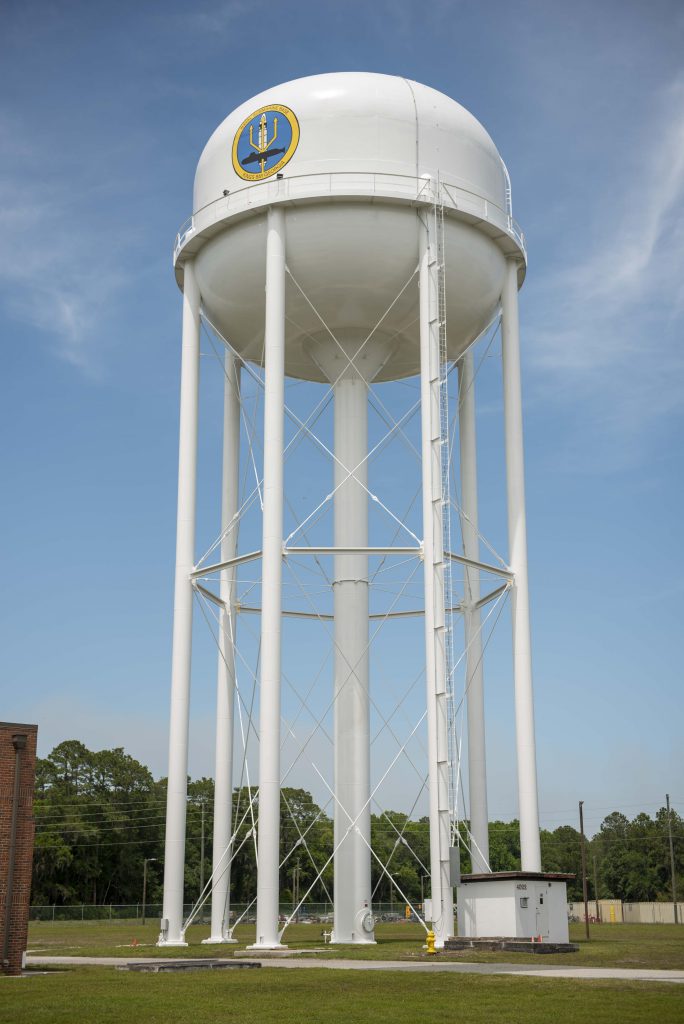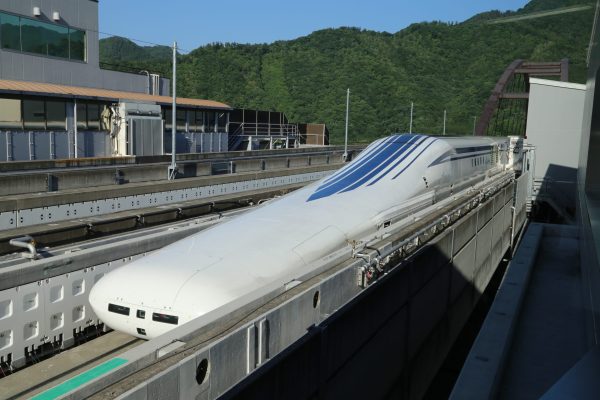By Eugene Snowden Jr., P.E.
The U.S. Navy’s potable water systems are a critical utility in support of the warfighter. This infrastructure may be consecutive water systems or include on-site production. While the Navy has to be prepared in every possible scenario for any manmade acts or natural hazard that may affect a water source, transmission, treatment, distribution, and storage, there are still vulnerabilities present in these systems.

to increase the resiliency of their water distribution systems.
PHOTOS COURTESY NAVAL SUBMARINE BASE KINGS BAY PUBLIC AFFAIRS
Proper planning and management are key to keeping water systems resilient and prepared for any emergency, while also ensuring continuous operations throughout the year.
To further protect water utilities nationwide, in 2018, America’s Water Infrastructure Act (AWIA) was signed into law. The legislation, which required applicable drinking water utilities to conduct a Risk and Resilience Assessment (RRA) and an updated Emergency Response Plan (ERP), led to Navy bases taking a more holistic view of specific risks as they pertain to malevolent acts and natural hazards on water systems and how the service responds in case of an emergency.
In cases where risks pertaining to malevolent acts and natural hazards were identified, Navy personnel used that data to propose and implement improvements. In some cases, it was determined that certain risks would always be prevalent, such as the threat of a Category 5 hurricane directly hitting a base located in the southeast United States.
Meeting Requirements
The implementation of AWIA across the Navy was performed over the course of a few years. RRAs were built first, then ERPs were developed based on the risks identified in an RRA. In some cases, an individual public works department built its own RRA and ERP in-house, while in other cases the RRA and ERP was completed using contract action. In still other cases, Naval Facilities Engineering Systems Command Atlantic assisted base public works departments in building their RRA and ERP.
Sites in California had to be evaluated for the highest risk natural disaster such as earthquake. In the southeast, the primary natural disaster to prepare for is a Category 5 hurricane. Bases in the Midwest are prone to tornadoes.
Phased Approach. A water system condition assessment or general description of the water system was used to build RRAs and ERPs. To perform these self assessments, the Navy used material and methodology supplied by the Environmental Protection Agency. AWIA requirements were completed in two phases, beginning with the RRA. This was required to be completed for Navy water systems serving a population over 3,300 where the service is the permit holder. In some locations, the base is not the water system permit holder; there, the Navy is essentially a customer of the local water utility provider.
Next, following completion of the RRA, the AWIA required that each Navy water system identified in Phase 1 create or update an ERP. The basic elements of the plan are general utility information, resilience strategies, emergency plans and procedures, mitigation actions, and detection strategies. An ERP also lists internal and external personnel to be notified for any emergency identified in AWIA Phase 1. An ERP then becomes an essential document for an emergency, including planning and training preparedness.

Addressing Risks
Implementation of the AWIA has further strengthened the Navy mission—by requiring community water systems to assess the risks to specific assets and to evaluate their resilience from both malevolent acts and natural hazards.
The methodology from the Environmental Protection Agency used the addressed malevolent acts and natural hazards, as well as dependency and proximity of threats to water sector operations. It also analyzes the cost-effectiveness of countermeasures to reduce risk. The methodology is based on assessing the risk to a water system asset from a specific threat or hazard. A subsequent monetary value of statistical illness and value of statistical life is assigned to injuries and deaths, respectively, so that risk can be determined as a single monetized value.
Prescribing Assessments. The Navy started with a characterization of water system resilience using the prescribed methodology and then conducted a qualitative risk assessment from malevolent acts and natural hazards to all the assets required in the AWIA. Each water system’s risk had to be analyzed for malevolent acts and natural hazards as they each pertained to a series of structural and systematic elements: physical barriers; source water; pipes, constructed conveyances, water collection, and intake; pretreatment and treatment; storage and distribution facilities; electronic, computer, or other automated systems (including the security of such systems); monitoring practices; financial infrastructure; the use, storage, or handling of chemicals; and the operation and maintenance of the utility.
All these items had to be tailored to build the qualitative risk assessment. For example, a base’s water system may be consecutive and not have onsite treatment. In other cases, a water system may include on-site production wells, a transmission main, and a water treatment plant. Sites in California had to be evaluated for the highest risk natural disaster such as earthquake. In the southeast, the primary natural disaster to prepare for is a Category 5 hurricane. Bases in the Midwest are prone to tornadoes.

the ability of military installations such as Naval Submarine Base Kings Bay to plan necessary water infrastructure projects.
The Environmental Protection Agency’s methodology assigned a default risk value to every scenario. In some cases, the Navy raised or lowered the default risk based on a variance of factors. Personnel then assigned a dollar value to replace every element that was theoretically damaged in any given scenario. Malevolent acts required some out-of-the-box thinking as well. Leadership had to work through how someone could intentionally damage or sabotage parts of a water system.
Following these steps, Navy personnel determined which assets and threats would undergo a quantitative risk assessment that analyzed risk scenarios identified in the qualitative risk assessment against a malevolent act or a natural hazard.
Starting with physical barriers, risk percentages and dollar values were assigned against malevolent acts and against natural hazards. The result was a report of monetized risk, utility financial impact, regional economic impact, fatalities, injuries, vulnerability likelihood, and annual threat likelihood.
The quantitative risk assessment could include a broad spectrum of assets encompassing the entire water system; in other cases it was limited to only those assets at highest risk. For threat selection, the methodology included all the malevolent acts, natural hazards, as well as dependency and proximity threats listed in the American Water Works Association J100-10 Standard, along with source water and finished water contamination. The Navy had the option to designate a custom threat depending on the local climate and water system configuration.
After completing a quantitative risk assessment under the current conditions for the water system, personnel made a decision whether or not to conduct an optional assessment of additional and potential countermeasures. When performed, this improvement analysis resulted in a profile of existing risk and a cost-benefit analysis of potential countermeasures to reduce risk.
Staying Prepared
In the past, the Navy had identified requirements to mitigate risk and prepare for emergencies. However, AWIA solidified RRAs and ERPs that had not been updated in many years. For example, after Naval Submarine Base Bay Kings Bay, Ga., executed the AWIA requirements, the installation improved its water system resiliency and planning by enhancing how it planned infrastructure projects and recapitalization investments.
RRA and ERP renewal is required every five years under AWIA. Because of the law, the Navy is in a much better position to plan for manmade or natural disasters and assist installations in proper planning and management, resiliency, and preparedness for any emergency while still ensuring continuous operations.
Eugene Snowden Jr., P.E., is Supervisory Civil Engineer, Public Works Utilities Management, NAVFAC Atlantic; eugene.r.snowden.civ@us.navy.mil.
More News from TME
-

Developing a Maglev Network for National Defense
A transportation network leveraging superconducting magnetic levitation technologies would bring benefits for logistics, surface transportation, and energy storage, as well as strengthen national defense priorities and the defense industrial base. -

Fulfilling the Mission
Rear Adm. Dean VanderLey, CEC, USN, Commander, Naval Facilities Engineering Systems Command, sits down with TME to discuss the Department of the Navy’s Systems Command for shore facilities and expeditionary equipment, Naval Facilities Engineering Systems Command (NAVFAC) and its varied responsibility that directly support warfighter lethality. -

Strengthening Installation Energy Resilience Through a Community of Practice
The Military Energy Resilience Catalyst strengthens installation energy resilience by providing opportunities for energy practitioners to develop professionally and connect with experts, senior leaders, and colleagues.